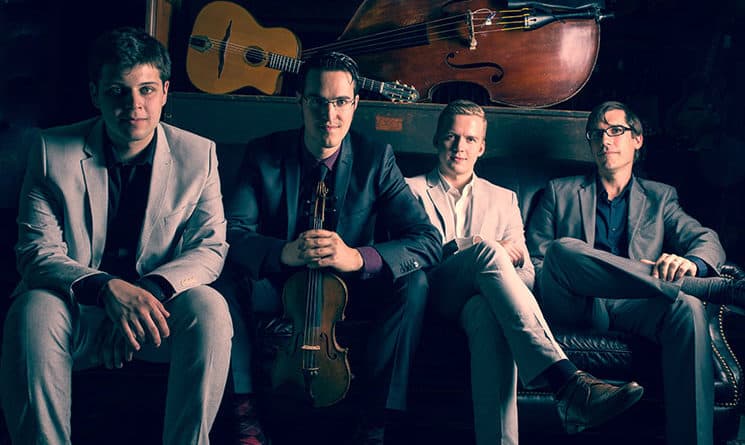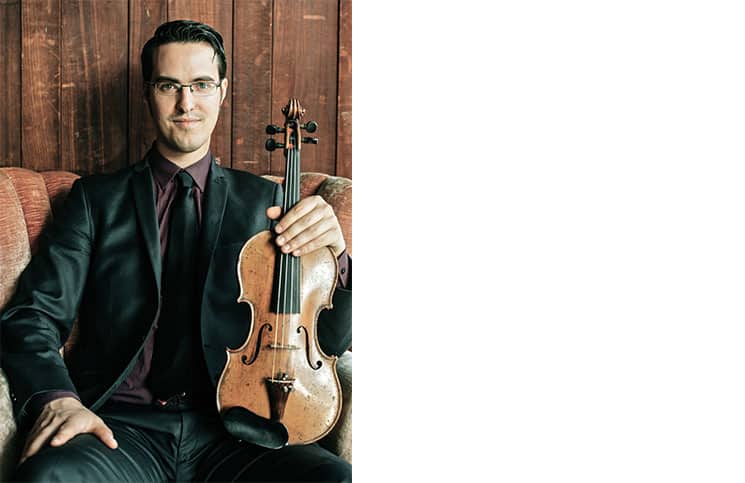Following last year’s inaugural Django by the Sea festival in Kittery, violinist Jason Anick was so enthused by the Seacoast’s creative community that he decided to move here. After living around Boston for the last eight years, Anick and his wife moved to Portsmouth in March.
“I really fell in love with the area after being involved with the festival and performing there and visiting it from time to time,” Anick said. “I really wanted to get more into the scene there, and the community, and it really felt like home every time I went.”
The second annual Django by the Sea festival takes place from Thursday to Sunday, Oct. 6 to 9. Following a free kick-off party on Thursday night at Portsmouth Book and Bar, the festival moves to its home base at The Dance Hall in Kittery for three days of concerts and workshops, with additional jam sessions at the nearby Buoy Gallery.
Anick is one of the event’s chief organizers and performers, playing violin for both the Rhythm Future Quartet and the John Jorgenson Quartet. “Busy weekend, yes,” he said. “But that’s kind of the life of a musician.”
A part-time teacher at the Berklee College of Music, Anick is a musician in high demand. His gypsy-jazz band, the Rhythm Future Quartet, released their sophomore album, “Travels,” earlier this year, following their self-titled debut in 2015. They’ve been touring relentlessly, with shows lined up through next May.
Anick recently spoke to The Sound by phone from Portland, Ore., where the band had a gig that night. He talked about the upcoming festival in Kittery, the growing appeal of gypsy jazz, and the legend of Django Reinhardt.
What do you think about the music scene here, and particularly the jazz scene? Have you gotten to know many other local musicians?
Yes, yeah, I have. It was sad to hear that the Birdseye Lounge (in Portsmouth) was closing, because they had a great jazz session where a lot of the top local players would meet and hang out and play. … For a smaller place, you’ve got quite a few venues in town. On any given week, there’s gonna be probably three or four jazz events going on. And more and more jazz artists are passing through. And then there’s all this fantastic music going on at the Prescott Park series. And with the proximity to Portland and Boston, there’s a lot of crossover between the musicians, especially ones who’ve lived in multiple areas.
What about the other band members (in Future Rhythm Quartet)? Do any of them live around here?
Yeah so, Greg Loughman, our bassist, and Max O’Rourke, the guitar player, they live more in this area. They live in Boston. And Olli Soikkeli, our lead guitar player from Finland, now lives in Manhattan. So we’re all on the East Coast, and he comes up to Boston a lot, we get down to New York a lot. But really, the majority of our gigs are on the road, traveling. So, Portsmouth is more like a home base.
Do you tour nationally and internationally?
Yeah. Even this year, I think we’ve probably done about 25 states in the U.S., and went to some interesting places overseas. We played in Russia, we played in Spain, and we played in Finland. So we’ve been really traveling pretty far and wide.
The Django by the Sea festival is coming up Oct. 6 to 9. What is it about the gypsy-jazz genre that holds so much appeal for you?
Well, besides playing it and loving the aspect of actually creating the music, I think people that don’t play it just love being around it. They love the energy, the excitement, the rhythmic grooves. It has kind of an infectious quality about it. And I think when you have a festival like this and the music is really in the air — you’ve got people jamming and concerts, workshops — it really captures their spirit. To me, it’s like that excitement of a lot of people being around a campfire. It has a real communal vibe. The music really draws people in, both to play it and to listen to it. There’s a quality to it that’s so palpable, and people really feel like they can be a part of the whole process. So, that’s what we try to bring with the festival. It’s not just, “Oh, come to a concert,” but it’s a whole experience with the jam sessions, all the people and the fans. So it’s really trying to be a real community-builder as well.
When you started playing violin, were you trained as a jazz performer?
I started playing when I was 5. My dad got me playing, and he was a violin player as well. He played more on the bluegrass side … so I did some of that with my dad, alongside classical lessons since I was 5. I didn’t really get into jazz until maybe I was around 12 or 13. It was a little after my dad took me to see (gypsy-jazz violinist) Stephane Grappelli. I got to see and meet Stephane Grappelli when he was doing one of his last tours of the U.S. And as I started developing (when I was) 12, 13, I really started to enjoy the freedom that improvisation gave you. You really try to put your own stamp on music, and it felt very creative and freeing, so I kind of started off on a journey. And gypsy jazz, to me, is a great outlet as a violinist, because you have the expressiveness and all the textures that you create with the instrument itself, along with the freedom of improvisation that the jazz side creates. So it’s kind of the best of both worlds, musically and creatively.
Rhythm Future Quartet released its second album this year. While the first album was focused largely on old gypsy-jazz classics, the new one features more original material. Is that right?
Yeah, I think it’s about nine originals on the album, a couple from each band member.
Outside of gypsy jazz, are there other types of music that inform the sound on “Travels”?
Well, we’ve certainly been listening to a lot of world music, music from Brazil and Balkan regions, as well as bringing in different eras of jazz. So, people generally associate gypsy jazz with some of the older swing from the ’30s and ’40s, but we like to bring in different years of jazz into that as well, whether it’s pulled from a Charlie Parker kind of bebop style or a more contemporary jazz style. And also, I bring in a lot from classical music as well. There’s a couple of very chamber-esque things. … So it’s always an open book and an open palette. I always consider it jazz without borders. I don’t try to constrain myself to doing one thing, and I think that brings a very creative approach to it.
So the band members write songs individually and then bring them all together as a group?
We usually, when there’s an original song, somebody from the group will have kind of a shell of it, or the meat and potatoes of the song. And then we’ll all start to craft it into more of a full composition. … So usually the spark of the idea comes from one player. Although there’s one song that Max and I composed together that was on the album, so that happens too. And there’s, of course, a lot of co-arranging. So, we did the song “Come Together,” the Beatles tune. That one kind of came organically as we tried to play through it and shape our individual parts to that.
As a teacher and a performer, do you find there is a growing audience for gypsy jazz?
I certainly believe so. I’m starting to see it more and more, not just through Berklee but through clinics I’ve been giving around the country and overseas as well. I think there’s a lot of people interested in — I hesitate to say more creative outlets as a string player, because classical music can be creative as well, but I think a lot of people that are coming from classical enjoy playin


